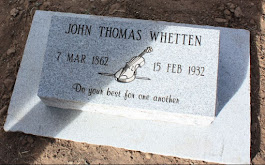CIVIL WAR, WISCONSIN 38th & FORT MAHONE
 The Civil War started in April 1861, the year before Peter Atkin left England at age 15. Peter was my great grandmother Sophia Atkin Whetten's younger brother. In August 1864, Peter enlisted in the Union Army at age 17. Peter lied about his age as his enlistment paper states he was 18. Since the minimum age for enlistment was 18, boys did lie about their ages. The Wisconsin Volunteer Infantry, 38th Regiment, Company G, recruited Peter and his cousin William Haynes in Cross Plains. Cousin William, age 32, was married with three young children.
The Civil War started in April 1861, the year before Peter Atkin left England at age 15. Peter was my great grandmother Sophia Atkin Whetten's younger brother. In August 1864, Peter enlisted in the Union Army at age 17. Peter lied about his age as his enlistment paper states he was 18. Since the minimum age for enlistment was 18, boys did lie about their ages. The Wisconsin Volunteer Infantry, 38th Regiment, Company G, recruited Peter and his cousin William Haynes in Cross Plains. Cousin William, age 32, was married with three young children. [ Photo: Peter Atkin on left side, William Haynes with beard]
The Wisconsin 38th, organized only four months earlier, was stationed in Virginia to assist with the 292-day Siege of Petersburg from April 1864 to July 1865. During the Siege of Petersburg, Union General-in-Chief Ulysses S. Grant conducted trench warfare to wear down General Robert E. Lee’s Confederate Army of Northern Virginia and to cut off needed supplies and supply lines. The Army of Northern Virginia managed to defend Richmond, the Confederate capital, and the important railroad and supply center of Petersburg, 23 miles south, for over nine months.
With the Union victory at the Battle of Five Forks, on April 1, 1865, the Confederate right flank and rear were exposed. Robert E. Lee’s instructions had been to “defend Five Forks at all hazards” due to its strategic importance. Now Grant and the Union Army of the Potomac held Five Forks and the road to the vital South Side Railroad. Confederate casualties, prisoners, and desertions caused the thinly held Confederate lines at Petersburg to be stretched beyond the ability of the Confederates to man them adequately.
A year earlier, the Confederate Army had established Fort Mahone to defend Petersburg. Fort Mahone, called by the Union troops Fort Damnation, was thought to be their strongest fort. William Haynes and Peter Atkin were among the 14,000 men ordered to take Fort Mahone. They charged at the first appearance of light on April 2, 1865, going against 1500 Confederate defenders.
The Confederate sharpshooters had clear targets and the fort’s defenses were formidable. Defenses included a double row of wooden abatis [formed by felled trees with sharpened branches facing the enemy],
fraise [pointed stakes driven into the ramparts in a horizontal or inclined position],
and chevaux de frise [a portable frame or log covered with many projecting long iron or wooden spikes or spears],
plus a waist-deep ditch filled with muddy water. Union soldiers with hatchets and axes cut through these obstacles during the night to clear a path for the charge at dawn.
Fighting back and forth, both sides held parts of the fort into the night. Meanwhile, Confederate President Jefferson Davis, most of his cabinet, and all the gold in the Confederate treasury left Richmond by train heading southwest for Danville, Virginia, before midnight, the night of April 2-3. Most of the remaining Confederate Army also fled.
While charging Fort Mahone, Peter was hit in his left side by a piece of a shell, but the wound was not serious. Cousin William Haynes, though, received a musket ball to his right wrist that required amputation.
Taken to Carver Army General Hospital in Washington, D.C, roughly 140 miles away, the lower third of William’s right arm was hacked off one week after he was shot. This surgery, on April 9th, would have been performed with no anesthesia to dull the pain nor antibiotics to kill infection. Suffering an additional three weeks, William died May 1, 1865, and was buried that same day on the confiscated grounds of Robert E. Lee’s home.
The Custis-Lee Mansion, originally called Arlington House, overlooked Washington D.C. and had been inherited by Robert E. Lee from his father-in-law. Union soldiers took over the plantation when he accepted a command in the Confederate army, set up a tent city for the troops, and began burying their dead in his garden. The military burial ground later became known as Arlington National Cemetery.
President Abraham Lincoln and General Ulysses S. Grant visited Fort Mahone the day after its capture on April 3, 1865, even before the Union and Confederate dead had been removed. Lincoln was seen with a tear in his eye as he recognized among the dead, troops he had seen on guard just days earlier.
Most of the Union Army pursued the Army of Northern Virginia until they surrounded it, forcing Robert E. Lee to surrender that army on April 9, 1865, after the Battle of Appomattox Court House in Virginia.
Confederate forces across the South surrendered as news of Robert E. Lee’s surrender reached them. On April 26, 1865, Joseph E. Johnston surrendered not only the Army of Tennessee, but also the remaining Southern forces, to Major General William T. Sherman in North Carolina, effectively bringing the war to an end. Jefferson Davis was captured May 10, 1865.














